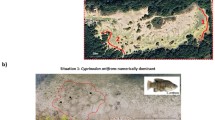Abstract
Territorial behavior of overwintered individuals of Metrocoris histriowas observed in an upstream area. Adults of both sexes held territories, but male territories were larger than those of females. Severe competition occurred among males for territories which give them access to receptive females. The effects of male body length and midleg length on establishment of territories were not significant. The effect of female midleg length on activity of females entering preferred foraging sites was equally not significant. Instead, territorial behavior increased with male age and males stayed longer at prime sites. Females of intermediate age were likely to occupy prime sites. Females had longer territory residence time than males. The sexes were dimorphic with respect to midleg length, and dimorphism in M. histriomay be related to a difference in life history, in that sexual selection may be relaxed due to asynchronous adult emergence patterns.
Similar content being viewed by others
References
Blanckenhorn, W. V. (1991a). Foraging groups of water striders: Effects of variability in handling times and prey arrivals.Behav. Ecol. Sociobiol. 28: 221–226.
Blanckenhorn, W. V. (1991b). Fitness consequences of foraging success in water striders (Gerris remigis; Heteroptera: Gerridae).Behav. Ecol. 2: 46–55.
Fairbairn, D. J. (1985). Comparative ecology ofGerris remigis (Hemiptera: Gerridae) in two habitats: A paradox of habitat choice.Can. J. Zool. 63: 2594–2603.
Fairbairn, D. J. (1990). Factors influencing sexual size dimorphism in temperature waterstriders.Am. Nat. 136: 61–86.
Hayashi, K. (1985). Alternative mating strategies in the waterstriderGerris elongatus (Heteroptera, Gerridae).Behav. Ecol. Sociobiol. 16: 301–306.
Kaitala, A. (1987). Dynamic life-history strategy of the waterstriderGerris thoracicus as an adaptation of food and habitat variation.Oikos 48: 125–131.
Kawabata, M. (1955). On the territorial organization and the social behaviour of a water-strider,Metrocoris histrio.Physiol. Ecol. Japan.6: 107–117 (in Japanese with English summary).
Miyamoto, S. (1961).Gerridae, Insecta Japonica Ser. 1, 3, Hokuryukan, Tokyo (in Japanese).
Nummelin, M. (1988). The territorial behaviour of four Ugandan waterstriders (Heteroptera, Gerridae): A comparative study.Ann. Entmol. Fennici. 54: 121–134.
Rowe, L., and Scudder, G. G. E. (1990). Reproductive rate and longevity in the waterstrider,Gerris buenoi.Can. J. Zool. 68: 399–402.
Rubenstein, D. I. (1984). Resource acquisition and alternative mating strategies in waterstriders.Am. Zool. 24: 345–353.
Spence, J. R., and Wilcox, R. S. (1986). The mating system of two hybridizing species of water striders (Gerridae). II. Alternative tactics of males and females.Behav. Ecol. Sociobiol. 19: 87–95.
Vepsäläinen, K., and Nummelin, M. (1985a). Female territoriality in the waterstridersGerris najas andG. cinereus.Ann. Zool. Fennici. 22: 433–439.
Vepsäläinen, K., and Nummelin, M. (1985b). Male territoriality in the waterstriderLimnoporus rufoscutellatus.Ann. Zool. Fennici. 22: 441–448.
Thornhill, R., and Alcock, J. (1983).The Evolution of Insect Mating Systems, Harvard, Cambridge, Mass.
Wilcox, R. S., and Ruckdeschel, T. (1982). Food threshold territoriality in a water strider (Gerris remigis).Behav. Ecol. Sociobiol. 11: 85–90.
Wilcox, R. S., and Spence, J. R. (1986). The mating system in two hybridizing species of water striders (Gerridae). I. Ripple signal functions.Behav. Ecol. Sociobiol. 19: 79–85.
Whitham, T. G. (1986). Costs and benefits of territoriality: Behavioral and reproductive release by competing aphids.Ecology 67: 139–147.
Author information
Authors and Affiliations
Rights and permissions
About this article
Cite this article
Koga, T., Hayashi, K. Territorial behavior of both sexes in the water striderMetrocoris histrio (Hemiptera: Gerridae) during the mating season. J Insect Behav 6, 65–77 (1993). https://doi.org/10.1007/BF01049148
Accepted:
Issue Date:
DOI: https://doi.org/10.1007/BF01049148




